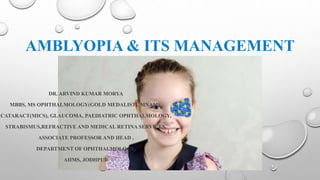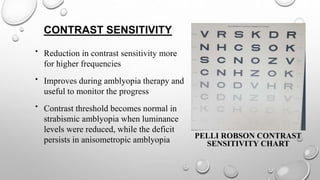The document discusses amblyopia, also known as lazy eye, detailing its definition, prevalence, and pathophysiology, which includes amblyogenic factors and visual deprivation. It categorizes different types of amblyopia based on causes and emphasizes the importance of early detection and treatment options, including refractive correction and occlusion therapy. Management strategies aim to restore visual acuity by correcting visual deprivation and encouraging use of the amblyopic eye, with specific therapies recommended based on the patient's age and compliance.
































































![Loss of depth feeling
Rash
Occlusion Amblyopia
DISADVANTAGES OF
OCCLUSION
Mental Pain
Low Adherence
4 [month] → 30%](https://image.slidesharecdn.com/amblyopiaslideshare-191005133628/85/Amblyopia-and-it-s-Management-65-320.jpg)
![Fig. Mean compliance with prescribed dose across all individuals still in treatment.
Days with fewer than 10 individuals remaining in treatment not shown.
VisualPsychophysicsandPhysiologicalOptics| September 2013ComplianceWith Occlusion Therapyfor
ChildhoodAmblyopia Michael P.Wallace;CatherineE.Stewart; Merrick J.Moseley; DavidA.Stephens;
Alistair R.Fielder
LOW ADHERENCE
4 [MONTH] → 30%](https://image.slidesharecdn.com/amblyopiaslideshare-191005133628/85/Amblyopia-and-it-s-Management-66-320.jpg)



































